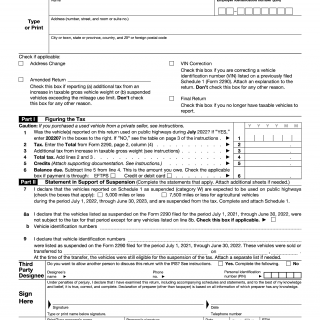IRS Form 2290. Heavy Highway Vehicle Use Tax Return
Form 2290, Heavy Highway Vehicle Use Tax Return is a tax form used by individuals or businesses that own and operate heavy vehicles on public highways in the United States.
The main purpose of the form is to report and pay the Heavy Vehicle Use Tax (HVUT) to the Internal Revenue Service (IRS). The form consists of several parts, including the taxpayer's information, vehicle information, and tax calculation.
The utilization of Form 2290 involves several purposes, including the determination and settlement of tax obligations for highway motor vehicles utilized within a particular time frame with a taxable gross weight of 55,000 pounds or more. It also covers the calculation and payment of tax liabilities for a vehicle that has already completed a suspension statement on another Form 2290 but later exceeded the mileage usage limit during the period. Additionally, it includes the assessment and remittance of tax dues in case the taxable gross weight of a vehicle increases and falls into a new category during the term.
Form 2290 is also necessary to claim a tax suspension for vehicles anticipated to cover 5,000 miles or less (7,500 miles or less for agricultural vehicles) during the period. The form allows one to request a credit for tax payments made on vehicles that were destroyed, stolen, sold, or used 5,000 miles or less (7,500 miles or less for agricultural vehicles). Furthermore, it requires reporting the acquisition of a used taxable vehicle that had a suspended tax obligation and the calculation and remittance of tax dues for a used taxable vehicle obtained and employed within the period.
Important fields to consider when filling out the form include the taxpayer's name, address, and Employer Identification Number (EIN), as well as the vehicle's identification number, weight, and first use month.
It is important to attach any additional documents that support the tax calculation, such as a Schedule 1 form. The due date for filing the form is August 31st of each tax year.
Examples of when the form may be required include individuals or businesses that own and operate heavy vehicles with a gross weight of 55,000 pounds or more. The form may also be required for vehicles that travel more than 5,000 miles on public highways during the tax year.
Strengths of the form include its ability to ensure compliance with tax laws and regulations, as well as its ability to generate revenue for the government. Weaknesses may include the potential for errors or misinterpretation of tax laws. Opportunities include the ability to claim credits or refunds for overpayment of taxes. Threats may include the possibility of penalties or legal action if the form is not filed correctly or on time.
Alternative forms for reporting and paying HVUT include electronic filing or paper filing. These forms may differ in the level of convenience or speed of processing.
The form can positively impact the future of the participants by ensuring compliance with tax laws and regulations, and avoiding penalties or legal action. The form is typically submitted to the IRS and may be stored for future reference.

